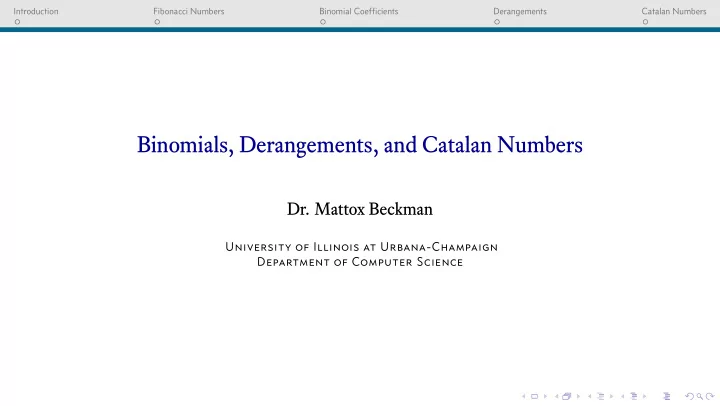

Introduction Fibonacci Numbers Binomial Coeffjcients Derangements Catalan Numbers Binomials, Derangements, and Catalan Numbers Dr. Mattox Beckman University of Illinois at Urbana-Champaign Department of Computer Science
Introduction Fibonacci Numbers Binomial Coeffjcients Derangements Catalan Numbers Objectives Your Objectives: ◮ Know how to calculate and use these sequences: ◮ Fibonacci ◮ Binomial Coeffjcients ◮ Derangements ◮ Catalan Numbers
Introduction Fibonacci Numbers Binomial Coeffjcients Derangements Catalan Numbers Zeckenorf’s Theorem ◮ We’ve talked about Fibonacci numbers already, but one tidbit: ◮ Every positive integer n = f i + f j where i + 1 > j . Try proving it! ◮ Use a greedy algorithm to fjnd f i and f j .
Introduction Fibonacci Numbers Binomial Coeffjcients Derangements Catalan Numbers Binomial Coeffjcients ◮ Coeffjcients of the expansion of ( x + y ) n e.g. ( x + y ) 4 = x 4 + 4 x 3 y + 6 x 2 y 2 + 4 xy 3 + y 4 ◮ Number of ways to chose k items from n objects. ( k starts at 0...) ◮ The formula: C ( n , k ) = n ! k !( n − k )! ◮ The recurrence: “either take or ignore an item” C ( n , 0) = C ( n , n ) = 1 C ( n , k ) = C ( n − 1 , k − 1) + C ( n − 1 , k ) ◮ Use DP if you need a lot, but not all, of these numbers.
Introduction Fibonacci Numbers Binomial Coeffjcients Derangements Catalan Numbers Derangements ◮ Number of permutations of n is n ! . ◮ But... how many ways are there to make a permutation such that no element is in its original spot? ◮ Written ! n !0 = 0 !1 = 0 ! n = ( n − 1) ∗ (!( n − 1)+!( n − 2)) ◮ !2 = 1 , !3 = 2 , !4 = 9 , !5 = 44 , !6 = 265 , ... ◮ Not that common, but easy to code with DP.
Introduction Fibonacci Numbers Binomial Coeffjcients Derangements Catalan Numbers Catalan Numbers ◮ This sequence has a lot of isomorphisms. ◮ Cat ( n ) = C (2 × n , n )/( n + 1); Cat (0) = 1 ◮ Recursively: Can ( n + 1) = (2 n +2)(2 n +1) ( n +2)( n +1) Cat ( n ) ◮ Cat (0) = 1 , Cat (1) = 1 , Cat (2) = 2 , Cat (3) = 5 , Cat (4) = 14 , ... ◮ Some things Catalan numbers count: ◮ Cat ( n ) – Number of distinct binary trees with n vertices. ◮ Number of ways n + 1 factors can be completely parethesized: abcd = a(b(cd)) = ((ab)c)d = (ab)(cd) = a((bc)d) = (a(bc))d ◮ Number of ways a convex polygon can be triangulated.
Recommend
More recommend